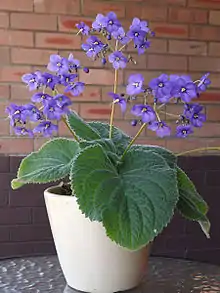Boea hygroscopica
Boea hygroscopica (known as rock violet) is one of 15 species of flowering plant of the Boea genus in the gesneriad family.[1] It is considered a 'resurrection plant' because of its ability to withstand virtually total water loss. Detached leaves of B. hydroscopica can withstand desiccation by increasing the small amount of constitutive glutathione by up to 50 times.
| Boea hygroscopica | |
|---|---|
 | |
| Scientific classification | |
| Kingdom: | Plantae |
| Clade: | Tracheophytes |
| Clade: | Angiosperms |
| Clade: | Eudicots |
| Clade: | Asterids |
| Order: | Lamiales |
| Family: | Gesneriaceae |
| Genus: | Boea |
| Species: | B. hygroscopica |
| Binomial name | |
| Boea hygroscopica | |
It is found in parts of Australia growing along creek beds, on moist banks and moss-covered rocks in rainforest, open forest, vine forest and gallery forest.[3]
Description
Boea hygroscopica is an herbaceous or woody plant growing no taller than 1 meter.[3]
The flowers are 20-22mm in diameter (about the diamter of a U.S. nickel). The peduncles (stems supporting the flowers) are 85-90mm long. There are 5 petals and they are dimorphic, with 2 larger ones (10x8mm) and 3 smaller ones (10x5mm).[3]
References
- "Boea hygroscopica F.Muell". Plants of the World Online.
- "Factsheets - Boea hygroscopica". Australian Tropical Rainforest Plants. Retrieved 2 Dec 2020.